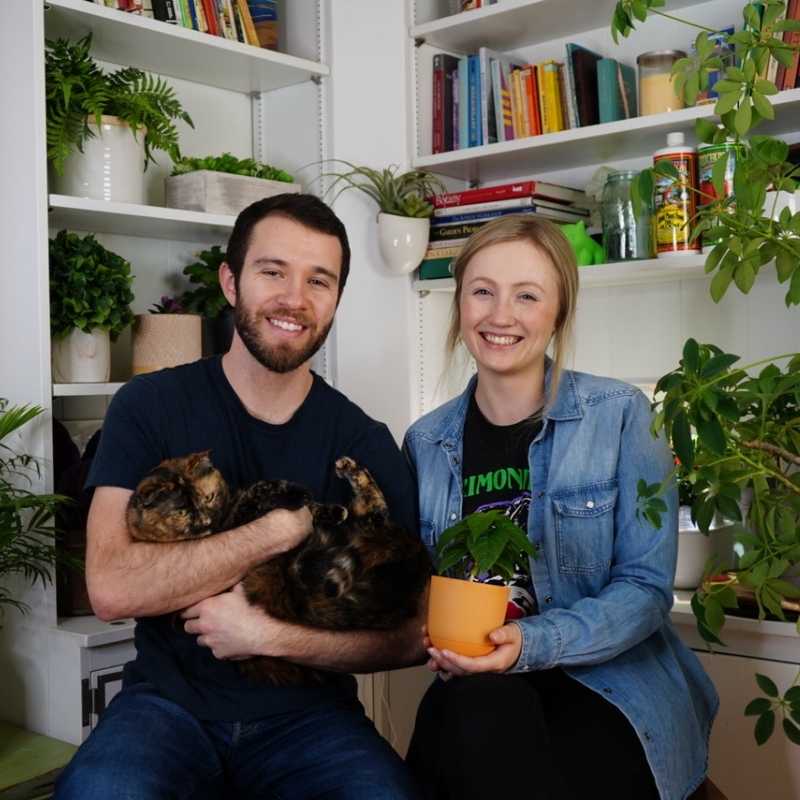20% Off USA-Made All-Metal Greenhouse Kits until May 31
20% Off USA-Made All-Metal Greenhouse Kits until May 31
Creating a Pepper Empire: Pepper Geek
October 25, 2023 4 min read 0 Comments

Peppers Are Our Way Of Life
Hi there, I’m Calvin from Pepper Geek. Crystalyn and I grow dozens of unique (and often bizarre) chili varieties each year and share it on our website * and YouTube channel.* What started as a love for spicy food grew into a passion for gardening and helping others grow the best pepper plants.
*Links will open new page.
How Pepper Geek Was Born
Crystalyn (Pepper Geek’s other half) and myself started our website back in 2018 with very modest and casual goals. “Hey, that’s a cool domain name, ‘peppergeek.’ Let’s buy it!” Twelve bucks later, and we had a website, but not much of a plan.
We started writing about spicy recipes and hot sauces, but our day jobs held us back from getting very far. It was only when we started writing about our pepper plants that we realized the website’s destiny.
Now, with over 200 articles and 75+ YouTube videos (and counting), we’re never looking back. The universe of pepper plants is incredibly diverse, strange, and exciting. It became clear that the chili pepper community serves as an amazing entry point into gardening for those who might otherwise ignore it, and we are so happy to be a part of that.

What’s So Great About Peppers?
Almost every home gardener has probably grown a bell pepper or jalapeño at some point. They’re tasty and highly versatile peppers that are great in the kitchen.
But did you know there are thousands of varieties from 5 unique domesticated species of Capsicum?
If you’re from South America, you are probably familiar with the aji amarillo (C. baccatum) and the manzano (C. pubescens) varieties. If you are an islander in the Caribbean, you’ll know all about the goat pepper (C. chinense). If you’re from Japan, you will have had santaka (C. annuum). And I hope you’ve tried tabasco peppers (C. frutescens) in one way or another.
These popular varieties are just the tip of the spicy iceberg. Today, both home growers and commercial seed suppliers use crossbreeding methods to create brand new varieties with unique characteristics.
So, if you’re comfortable starting your plants from seed, you have an ever-changing landscape of pepper options. With so many varieties, it can be difficult to narrow down the seed search to fit your garden, but it is a challenge we enjoy taking on each year.

Favorite Pepper Varieties?
While this is a hard question for us to answer, I imagine you’d be curious about what we enjoy growing most. Here are a few of the staple varieties we like to have on hand every year.
- 7 pot yellow (and most yellow superhots). Yellow C. chinense varieties are my personal favorite. They have distinct citrus notes, but usually also come packed with heat.
- Aji amarillo. A staple Peruvian C. baccatum variety with big, orange peppers. The only drawback is the long growing season.
- Banana. These are great for salads and stir-fries, but we use them most for making crunchy quick pickles.
- Cayenne. I love cayennes for their productivity and usefulness. They also make for a great fermented hot sauce.
- CGN 21500. This one is more obscure, but it is a land variety (naturally occurring) that has a beautiful, purple and peachy color when ripe and a great flavor.
- Jalapeño. We’ll never go a year without some type of jalapeño growing. One of the most essential peppers for summer and fall cooking!
- New Mexico/hatch. The New Mexico State University has developed a number of chile varieties suitable for arid climates. The peppers, typically harvested while still green, are incredibly delicious and versatile.
- Scotch bonnet (or similar). Scotch bonnets are great for hot sauce and for making spicy chili and stews.
These are just a handful of reliable, tasty, and usable pepper varieties we have grown. More than anything, I tell new growers to browse and try a few that are appealing to your tastes, and maybe step a bit out of your comfort zone. Then, take notes on which plants prove to be both useful and happy growing in your climate.

Helping Newbies and Continuing To Learn
The way I see it, it will always be most important to continue to learn from both our own trials and errors and those of other growers. Our first few years growing were tumultuous to say the least, but now we go into our seed starting with confidence and excitement every year.
Thankfully, there are countless pepper growers who are incredibly helpful and friendly. After a few years of sharing our methods with the pepper community, we have been met with nothing but open arms and plenty of quirky personalities.
If you get involved and share your intentions, there are generous enthusiasts who would be happy to welcome you into the chili growing club. Say hello in one of the many pepper communities online, or just leave a comment on a YouTube video.
Learn To Grow Peppers
If you’re a home gardener and want to learn how to grow peppers, Pepper Geek is a great place to start. Above all, just get started! You’ll learn so much by simply growing your first potted plant.
But be forewarned: After just one plant, you’ll probably be hooked on peppers for life!
- Calvin
P.S. If you grow anything that isn’t a pepper, check out our broader gardening website GeekyGreenhouse.com.
Subscribe
Sign up to get the latest on sales, new releases and more …
